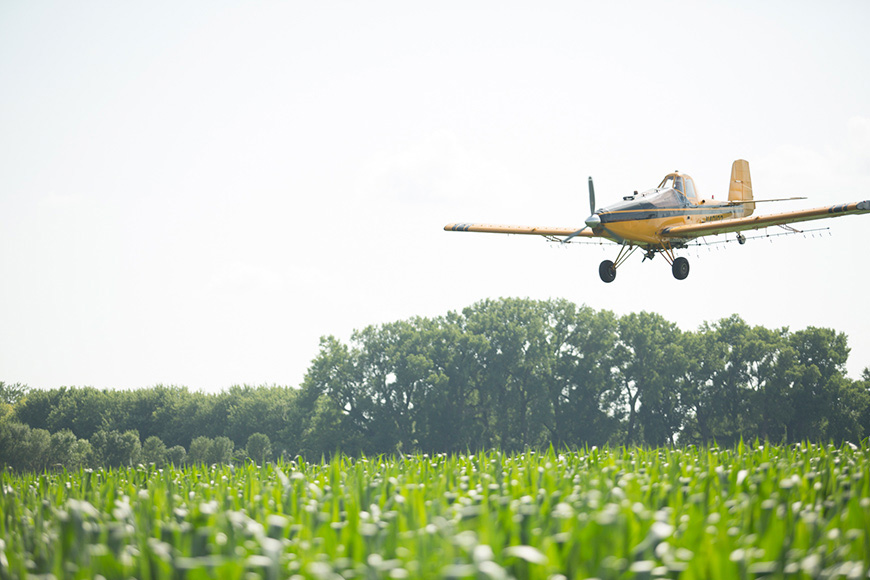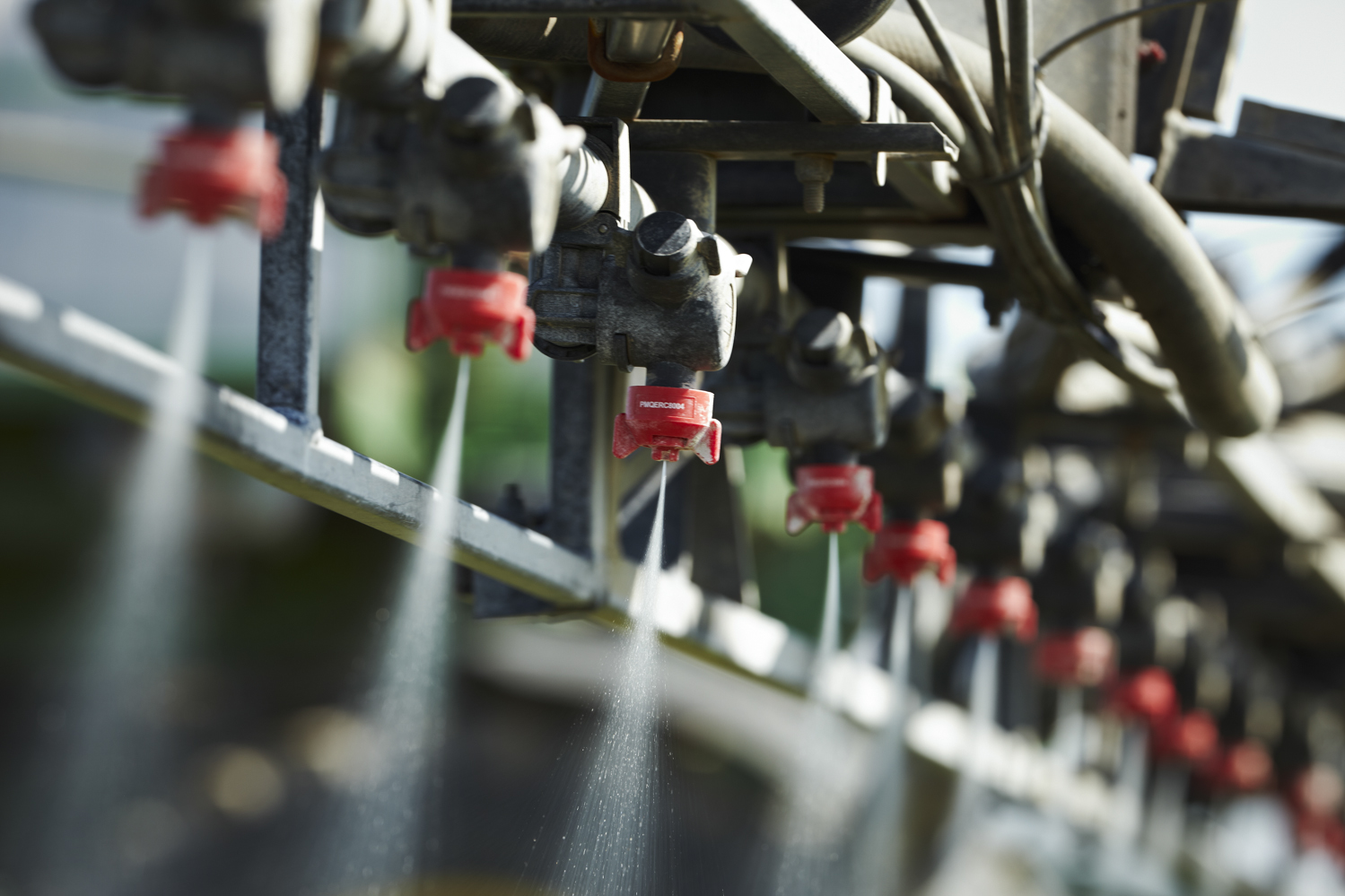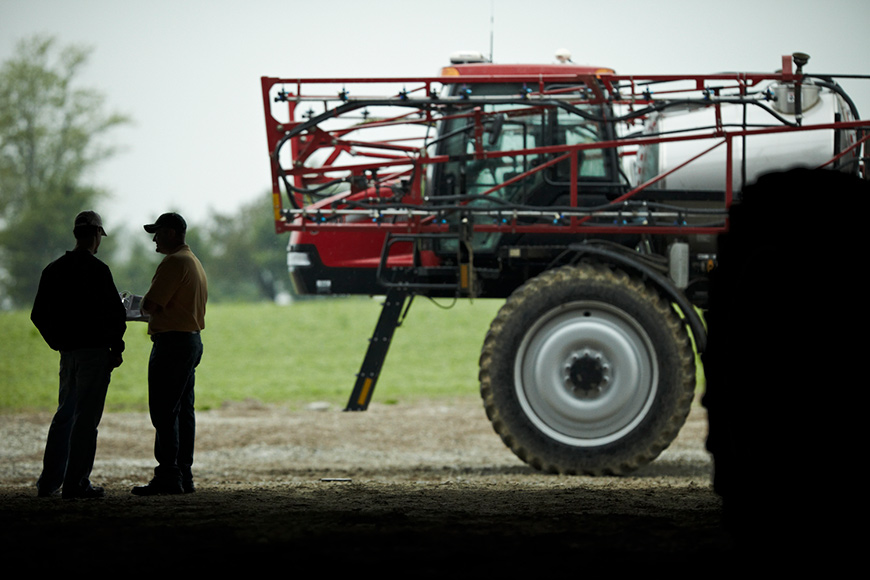Managing Weeds and Diseases Resulting From Wet Soils

Rain, rain and more rain. That about sums up the 2019 growing season so far in most regions of the country. Wet soils and unstable temperatures are causing two areas of primary concern:
1. Many corn and soybean crops have been planted with no burndown or preplant herbicide application. Wet, warm conditions will lead to larger-than-expected weeds, and higher herbicide use rates will increase the threat of crop response. How can you control tough weeds and keep your crops safe?
2. Corn that has been planted will face early-season disease pressure due to wet soils and residue from spring tillage left on the soil surface. An early fungicide application between V5-V8 can help manage disease. This will not replace a later application of a fungicide, but it will help to fight off early-season diseases that we often face in wet conditions – especially in corn-on-corn fields. How do you make sure your fungicide lands where it needs to in order to be most effective? And what technology tools can help you spot disease or other issues in your field?
Here are some general recommendations about how to approach each of these areas. Remember: It’s crucial to connect with your local trusted agronomic advisor to ensure you’re managing issues appropriately and taking advantage of the best application timing for your region and your operation.
Waterhemp, giant ragweed and marestail are other fast-growing weeds that can take over your fields quickly. Scout fields with your agronomist to identify problems so he or she can make accurate recommendations for your herbicide program.
Be alert for crop response. Weeds grow more slowly in cooler temperatures and also don’t build up a waxy cuticle on the leaves as quickly, making them more susceptible to a well-timed herbicide application. No matter what the temperature, be sure to add an adjuvant to your herbicide tank mix. If you do apply a herbicide on these weeds and then the weather warms, you may see a slight increase in burn on your crop. In warmer conditions, the waxy cuticle of the weed has time to develop, in which case, adjuvants are even more important to help penetrate the surface of the leaf. Also, avoid overlap when you’re applying your postemergence herbicide to reduce the chances of crop injury.
Use an adjuvant and herbicide together. Adding an adjuvant to the tank can help improve herbicide uptake and performance. For example, Class Act® NG® adjuvant is specifically formulated for use with glyphosate-based herbicides such as Cornerstone® Plus. Oil-based adjuvants such as Destiny® HC, Superb® HC or StrikeLock® are formulated to mix well with oil-based herbicides such as Avalanche® Ultra and Section® Three. Class Act® Ridion® adjuvant is formulated for use with dicamba herbicides. I also recommend adding InterLock® adjuvant to any herbicide-adjuvant tank mix. Consult with your agronomist for specific direction.
Don’t short your crops. With a compressed season, it’s tempting to cut back on application expenses. But you might have only one shot at making a postemergence herbicide application this year, so make it count. If you have to go back for a respray when your corn is at V12 or later, your herbicide options are severely limited and your chances of causing crop damage or other problems dramatically increases. Don’t cut rates and don’t cut out an adjuvant. Take the time to do it right the first time.
Don’t use less than the recommended rate. You may hear that if your plants are smaller than normal, you can cut down on your fungicide rates. This is not a recommended practice; in fact, it’s the quickest way to build resistance to a fungicide. Use the recommended rate.
Add an adjuvant to the tank. MasterLock® adjuvant combines InterLock and DropTight™ technologies in one crop-based adjuvant to enhance spray coverage. It can be used with fungicides and insecticides as well as herbicides and other crop protection products. Help ensure your fungicide hits its target by adding an adjuvant to the tank.
Use ag tech to identify problems and opportunities. This year, it will be critical to identify the parts of your fields that look good and should be invested in to optimize profitability potential, versus those areas that are drowned out and don’t need a micronutrient application or areas that are high in biomass as a result of weed outbreaks. In-season imagery from the R7® Tool can help you identify these situations and more, which allows you to concentrate your inputs on the places that have the greatest yield and ROI potential. Of course, be sure to go into the field and verify what imagery is indicating. Additionally, the R7 Field Forecasting Tool can help you predict nitrogen usage and make decisions on side-dressing and how much nitrogen you should apply.
Bottom line: Don’t write this season off. Once we dry out, you’ll have opportunities to apply herbicides, fungicides and crop nutrients to help protect your yield and ROI potential. Work closely with your agronomist to make sure you give your crops a fair shot at success.
© 2019 WinField United. Avalanche®, Class Act®, Cornerstone®, Destiny®, DropTight™, InterLock®, MasterLock®, NG®, Ridion®, RustEase®, Section®, StrikeLock® Superb®, R7® and WinField® are trademarks of WinField United.
1. Many corn and soybean crops have been planted with no burndown or preplant herbicide application. Wet, warm conditions will lead to larger-than-expected weeds, and higher herbicide use rates will increase the threat of crop response. How can you control tough weeds and keep your crops safe?
2. Corn that has been planted will face early-season disease pressure due to wet soils and residue from spring tillage left on the soil surface. An early fungicide application between V5-V8 can help manage disease. This will not replace a later application of a fungicide, but it will help to fight off early-season diseases that we often face in wet conditions – especially in corn-on-corn fields. How do you make sure your fungicide lands where it needs to in order to be most effective? And what technology tools can help you spot disease or other issues in your field?
Here are some general recommendations about how to approach each of these areas. Remember: It’s crucial to connect with your local trusted agronomic advisor to ensure you’re managing issues appropriately and taking advantage of the best application timing for your region and your operation.
Postemergence herbicide applications on corn and soybeans
Know the type and size of your weeds. Whether your temperatures are trending cooler or warmer, know what weeds you have in the field and how large they are. Now that it’s June and our temperatures will start to climb, those weeds will be growing very quickly. Take Palmer amaranth, for example, which we deal with here in southern Iowa. This glyphosate-resistant weed can grow 2 inches in 24 hours, and we’d want to spray that weed when it’s in the 4- to 6-inch range. So with all the rain we’ve been getting, farmers here have about a three-day window to deal with it.Waterhemp, giant ragweed and marestail are other fast-growing weeds that can take over your fields quickly. Scout fields with your agronomist to identify problems so he or she can make accurate recommendations for your herbicide program.
Be alert for crop response. Weeds grow more slowly in cooler temperatures and also don’t build up a waxy cuticle on the leaves as quickly, making them more susceptible to a well-timed herbicide application. No matter what the temperature, be sure to add an adjuvant to your herbicide tank mix. If you do apply a herbicide on these weeds and then the weather warms, you may see a slight increase in burn on your crop. In warmer conditions, the waxy cuticle of the weed has time to develop, in which case, adjuvants are even more important to help penetrate the surface of the leaf. Also, avoid overlap when you’re applying your postemergence herbicide to reduce the chances of crop injury.
Use an adjuvant and herbicide together. Adding an adjuvant to the tank can help improve herbicide uptake and performance. For example, Class Act® NG® adjuvant is specifically formulated for use with glyphosate-based herbicides such as Cornerstone® Plus. Oil-based adjuvants such as Destiny® HC, Superb® HC or StrikeLock® are formulated to mix well with oil-based herbicides such as Avalanche® Ultra and Section® Three. Class Act® Ridion® adjuvant is formulated for use with dicamba herbicides. I also recommend adding InterLock® adjuvant to any herbicide-adjuvant tank mix. Consult with your agronomist for specific direction.
Don’t short your crops. With a compressed season, it’s tempting to cut back on application expenses. But you might have only one shot at making a postemergence herbicide application this year, so make it count. If you have to go back for a respray when your corn is at V12 or later, your herbicide options are severely limited and your chances of causing crop damage or other problems dramatically increases. Don’t cut rates and don’t cut out an adjuvant. Take the time to do it right the first time.
Fungicide applications on corn and soybeans
Use multiple modes of action. Apply a fungicide with multiple modes of action because your plants will be growing rapidly and you’ll want to manage any disease pressure quickly. A good combination might be a fungicide that contains a triazole or a succinate dehydrogenase inhibitor (SDHI), mixed with a strobilurin fungicide. For example, RustEase® is a broad-spectrum, preventive fungicide recommended for the control of many corn and soybean diseases.Don’t use less than the recommended rate. You may hear that if your plants are smaller than normal, you can cut down on your fungicide rates. This is not a recommended practice; in fact, it’s the quickest way to build resistance to a fungicide. Use the recommended rate.
Add an adjuvant to the tank. MasterLock® adjuvant combines InterLock and DropTight™ technologies in one crop-based adjuvant to enhance spray coverage. It can be used with fungicides and insecticides as well as herbicides and other crop protection products. Help ensure your fungicide hits its target by adding an adjuvant to the tank.
Use ag tech to identify problems and opportunities. This year, it will be critical to identify the parts of your fields that look good and should be invested in to optimize profitability potential, versus those areas that are drowned out and don’t need a micronutrient application or areas that are high in biomass as a result of weed outbreaks. In-season imagery from the R7® Tool can help you identify these situations and more, which allows you to concentrate your inputs on the places that have the greatest yield and ROI potential. Of course, be sure to go into the field and verify what imagery is indicating. Additionally, the R7 Field Forecasting Tool can help you predict nitrogen usage and make decisions on side-dressing and how much nitrogen you should apply.
Bottom line: Don’t write this season off. Once we dry out, you’ll have opportunities to apply herbicides, fungicides and crop nutrients to help protect your yield and ROI potential. Work closely with your agronomist to make sure you give your crops a fair shot at success.
© 2019 WinField United. Avalanche®, Class Act®, Cornerstone®, Destiny®, DropTight™, InterLock®, MasterLock®, NG®, Ridion®, RustEase®, Section®, StrikeLock® Superb®, R7® and WinField® are trademarks of WinField United.




